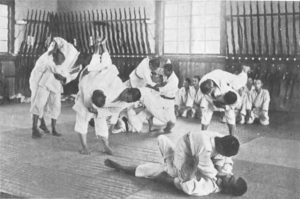קלאַפּ, Vol. 2
With קלאַפּ, Vol. 2 (אַמאַזאָן צוגעבן לינק), Roberto Pedrera פּיקס אַרויף די געשיכטע פון בראַזיליאַן דזשיו-דזשיצו אין וואָס ער האלט זיין כיידיי אין Brazil, 1950 – 1960. חוץ קאַרלאָס און העליאָ גראַסי, עטלעכע אנדערע אַקאַדעמיעס, אַזאַ ווי אָסוואַלדאָ פאַדדאַ, זענען אויך געבליבען. דזשודאָ איז גיינינג אין פּאָפּולאַריטעט אָבער האט נישט באַקומען דזשיו-דזשיצו אין פּאָפּולאַריטעט.
Vale Tudo matches were at the height of their popularity and regularly televised. Gracie Academy students were featured on television with other grapplers and professional wrestlers in competitive grappling contests.

Jujitsu Practice at a Japanese Agricultural School in 1922
Helio Gracie took part in the most important matches of his professional fighting career in his late 30s and early 40s. Helio drew with and defeated Kato. He lost to Kimura and Waldemar Santana. Despite the losses, Helio fought well for his age and emerged with a stronger reputation than when he entered the contests.
אָבער, the most significant development in the spread of Brazilian Jiu-Jitsu was the emergence of the second generation of Gracies, Carlson and Robson Gracie, plus their close friend Joao Alberto Barreto. Throughout the 1950s, these three men defended the reputation of the academy against all challenges. While Carlson was considered the family champion after avenging his uncle’s loss to Santana, Robson fought many challenge matches during this time. It was only Robson’s small size, which prevented him from answering all the challenges made to the academy.
While Pedreira still shares his rather low opinion of Carlos and Helio Gracie, he obviously respected the younger Gracies. While he does change his opinion of one of the second generation in the last volume of קלאַפּ, he writes well of them in this volume. Fans of BJJ history should read this volume to learn more about Robson and Joao Alberto Barreto alone.
קלאַפּ, Volume 2 is more readable at half the length of Volume 1. Volume 2 is 443 pages. While a more developed narrative style would help the reading experience, this book is a must read for those interested in Brazilian Jiu-Jitsu history not told from a Gracie perspective.
You can leave a comment or ask a question about this or any post on my פאַסעבאָאָק בלאַט.
שפּילקע עס
